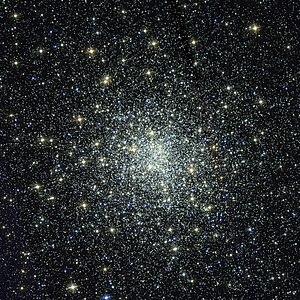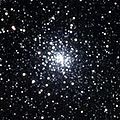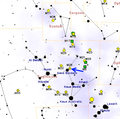| Messier 28 | |
|---|---|
 Globular cluster Messier 28 in Sagittarius Globular cluster Messier 28 in Sagittarius | |
| Observation data (J2000 epoch) | |
| Class | IV |
| Constellation | Sagittarius |
| Right ascension | 18 24 32.89 |
| Declination | –24° 52′ 11.4″ |
| Distance | 18.26 ± 0.98 kly (5.6 ± 0.3 kpc) |
| Apparent magnitude (V) | 6.8 |
| Apparent dimensions (V) | 11′.2 |
| Physical characteristics | |
| Mass | 5.51×10 M☉ |
| Radius | 30 ly |
| VHB | 15.55 ± 0.10 |
| Metallicity | = –1.32 dex |
| Estimated age | 12.0 Gyr |
| Notable features | Contains first pulsar discovered in a globular |
| Other designations | GCl 94, M 28, NGC 6626 |
| See also: Globular cluster, List of globular clusters | |
Messier 28 or M28, also known as NGC 6626, is a globular cluster of stars in the center-west of Sagittarius. It was discovered by French astronomer Charles Messier in 1764. He briefly described it as a "nebula containing no star... round, seen with difficulty in 31⁄2-foot telescope; Diam 2′."
In the sky it is less than a degree to the northwest of the 3rd magnitude star Kaus Borealis (Lambda Sgr). This cluster is faintly visible as a hazy patch with a pair of binoculars and can be readily found in a small telescope with an 8 cm (3.1 in) aperture, showing as a nebulous feature spanning 11.2 arcminutes. Using an aperture of 15 cm (5.9 in), the core becomes visible and a few distinct stars can be resolved, along the periphery. Larger telescopes will provide greater resolution, one of 25 cm (9.8 in) revealing a dense 2′ core, with more density within.
It is about 18,300 light-years away from Earth. It is about 551000 M☉ and its metallicity (averaging −1.32 which means more than 10 times less than our own star), coherency and preponderence of older stellar evolution objects, support its dating to very roughly 12 billion years old. 18 RR Lyrae type variable stars have been found within.
It bore the first discovery of a millisecond pulsar in a globular cluster – PSR B1821–24. This was using the Lovell Telescope at Jodrell Bank Observatory, England. A total of 11 further of these have since been detected in it with the telescope at Green Bank Observatory, West Virginia. As of 2011, these number the third-most in a cluster tied to the Milky Way, following Terzan 5 and 47 Tucanae.
Gallery
-
 Messier 28 taken by Hubble.
Messier 28 taken by Hubble.
-
 2.5' view of M28 taken by Hubble Space Telescope.
2.5' view of M28 taken by Hubble Space Telescope.
-
 Messier 28 on 2MASS; wide angle
Messier 28 on 2MASS; wide angle
-
 Map showing location of M28
Map showing location of M28
See also
References and footnotes
References
- Shapley, Harlow; Sawyer, Helen B. (August 1927), "A Classification of Globular Clusters", Harvard College Observatory Bulletin, 849 (849): 11–14, Bibcode:1927BHarO.849...11S.
- ^ "M 28". SIMBAD. Centre de données astronomiques de Strasbourg. Retrieved 2006-11-16.
- ^ Oliveira, R. A. P.; Ortolani, S.; Barbuy, B.; Kerber, L. O.; Maia, F. F. S.; Bica, E.; Cassisi, S.; Souza, S. O.; Pérez-Villegas, A. (2022). "Precise distances from OGLE-IV member RR Lyrae stars in six bulge globular clusters". Astronomy & Astrophysics. 657: A123. arXiv:2110.13943. Bibcode:2022A&A...657A.123O. doi:10.1051/0004-6361/202141596. S2CID 239998638.
- "Messier 28". SEDS Messier Catalog. Retrieved 21 July 2024.
- ^ Inglis, Mike (2004), Astronomy of the Milky Way: Observer's guide to the northern sky, Patrick Moore's Practical Astronomy Series, vol. 1, Springer, p. 21, Bibcode:2003amwn.book.....I, ISBN 978-1852337094.
- ^ Boyles, J.; et al. (November 2011), "Young Radio Pulsars in Galactic Globular Clusters", The Astrophysical Journal, 742 (1): 51, arXiv:1108.4402, Bibcode:2011ApJ...742...51B, doi:10.1088/0004-637X/742/1/51, S2CID 118649860.
- From trigonometry: radius = distance × sin( diameter_angle / 2 ) = 30 ly
- Testa, Vincenzo; et al. (February 2001), "Horizontal-Branch Morphology and Dense Environments: Hubble Space Telescope Observations of Globular Clusters NGC 2298, 5897, 6535, and 6626", The Astronomical Journal, 121 (2): 916–934, Bibcode:2001AJ....121..916T, doi:10.1086/318752
- ^ Koleva, M.; et al. (April 2008), "Spectroscopic ages and metallicities of stellar populations: validation of full spectrum fitting", Monthly Notices of the Royal Astronomical Society, 385 (4): 1998–2010, arXiv:0801.0871, Bibcode:2008MNRAS.385.1998K, doi:10.1111/j.1365-2966.2008.12908.x, S2CID 17571531
- ^ "JBO - Stars". Jodrell Bank Observatory. Retrieved 2007-06-01.
- ^ Thompson, Robert Bruce; Thompson, Barbara Fritchman (2007), Illustrated Guide to Astronomical Wonders, Diy Science, O'Reilly Media, Inc., p. 402, ISBN 978-0596526856.
- Burnham, Robert (1979), Burnham's celestial handbook: an observer's guide to the universe beyond the solar system, Dover books explaining science, vol. 3 (2nd ed.), Dover Publications, p. 1609, ISBN 978-0486236735
- Bogdanov, Slavko; et al. (April 2011), "Chandra X-ray Observations of 12 Millisecond Pulsars in the Globular Cluster M28", The Astrophysical Journal, 730 (2): 81, arXiv:1101.4944, Bibcode:2011ApJ...730...81B, doi:10.1088/0004-637X/730/2/81, S2CID 118621389
- "Nebulous, but no nebula". www.spacetelescope.org. Retrieved 11 March 2019.
Footnotes
- On July 27
External links
- Globular Cluster M28 @ SEDS Messier pages
- Messier 28, Galactic Globular Clusters Database page
- Messier 28 on WikiSky: DSS2, SDSS, GALEX, IRAS, Hydrogen α, X-Ray, Astrophoto, Sky Map, Articles and images
| Messier objects | ||
|---|---|---|
| List |
|  |
| See also | ||
| New General Catalogue 6500 to 6999 | |
|---|---|
| |
 = –1.32
= –1.32